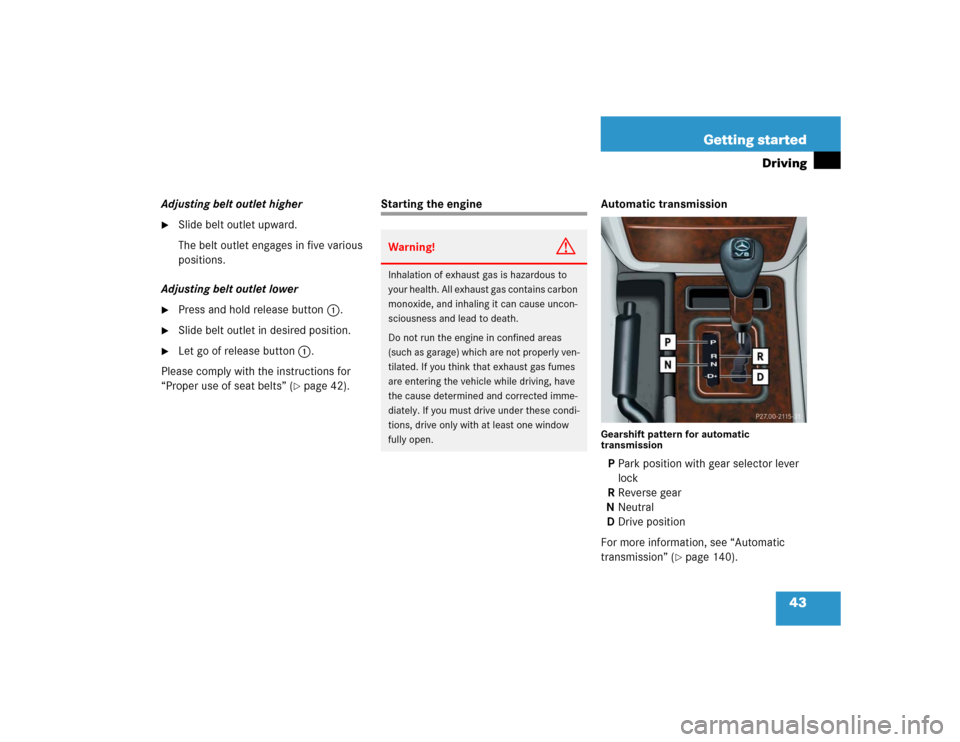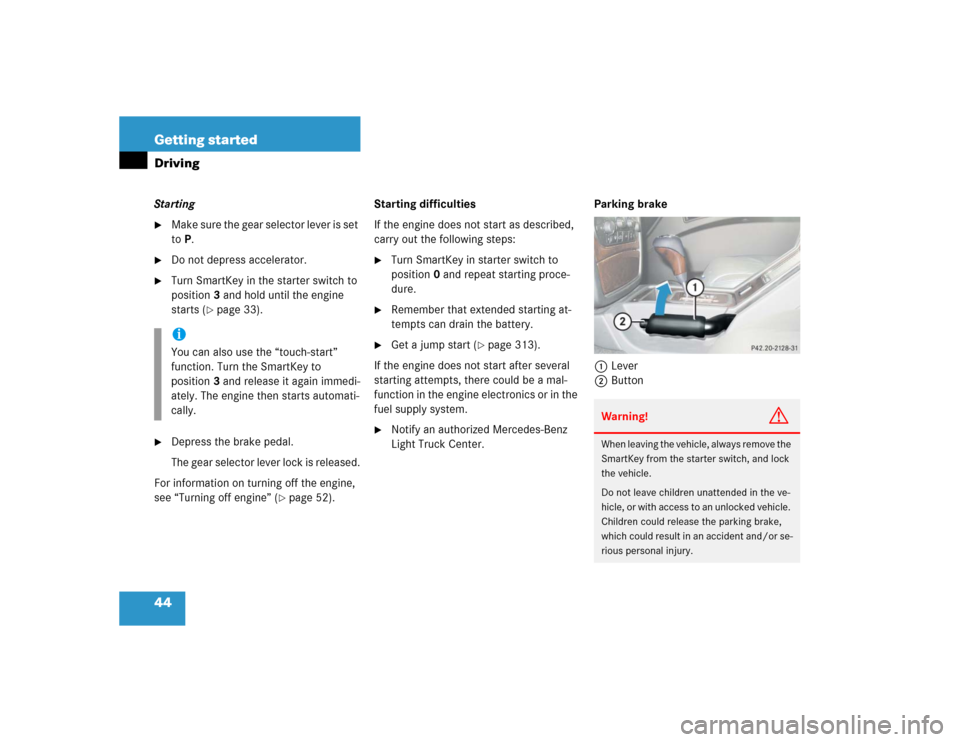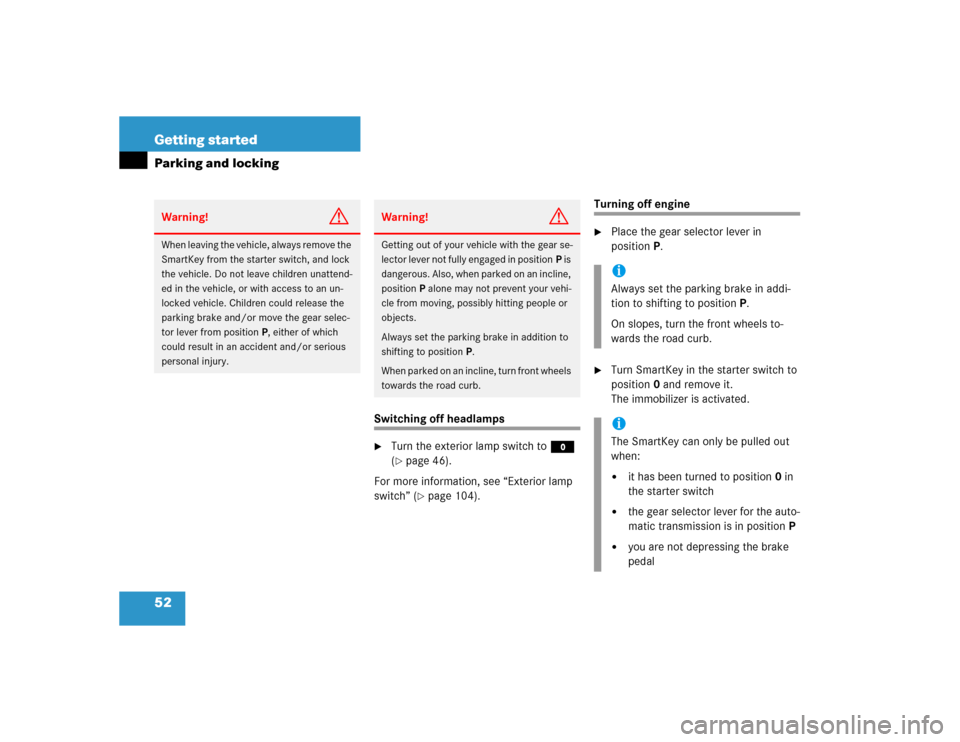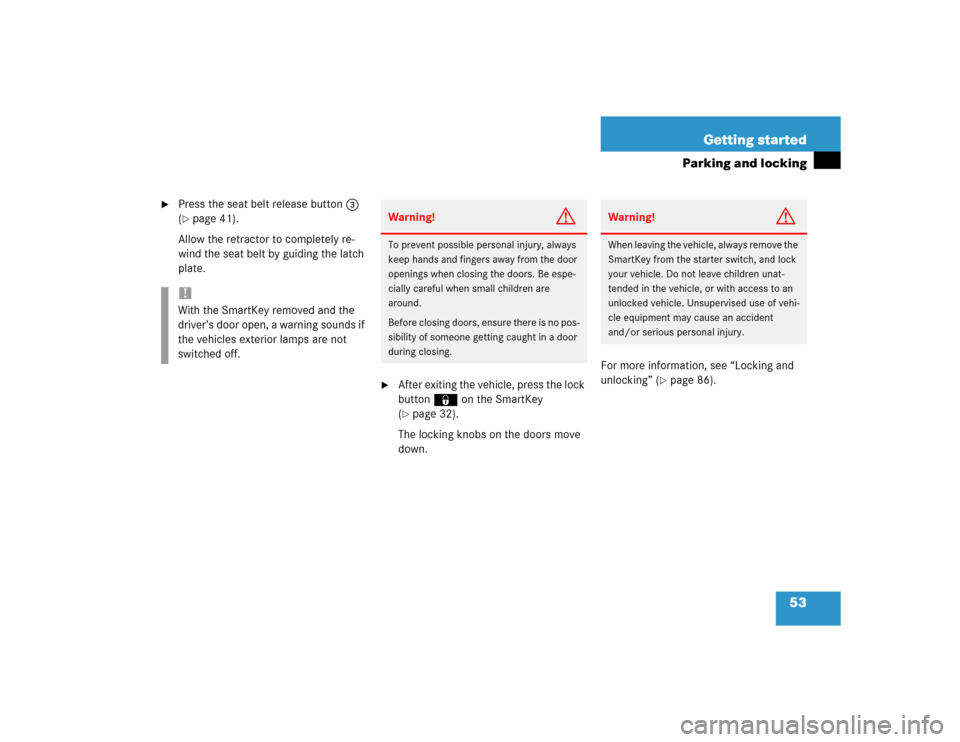Page 43 of 376

43 Getting started
Driving
Adjusting belt outlet higher�
Slide belt outlet upward.
The belt outlet engages in five various
positions.
Adjusting belt outlet lower
�
Press and hold release button1.
�
Slide belt outlet in desired position.
�
Let go of release button1.
Please comply with the instructions for
“Proper use of seat belts” (
�page 42).
Starting the engine Automatic transmission
Gearshift pattern for automatic
transmissionPPark position with gear selector lever
lock
RReverse gear
NNeutral
DDrive position
For more information, see “Automatic
transmission” (
�page 140).
Warning!
G
Inhalation of exhaust gas is hazardous to
your health. All exhaust gas contains carbon
monoxide, and inhaling it can cause uncon-
sciousness and lead to death.
Do not run the engine in confined areas
(such as garage) which are not properly ven-
tilated. If you think that exhaust gas fumes
are entering the vehicle while driving, have
the cause determined and corrected imme-
diately. If you must drive under these condi-
tions, drive only with at least one window
fully open.
Page 44 of 376

44 Getting startedDrivingStarting�
Make sure the gear selector lever is set
toP.
�
Do not depress accelerator.
�
Turn SmartKey in the starter switch to
position3 and hold until the engine
starts (
�page 33).
�
Depress the brake pedal.
The gear selector lever lock is released.
For information on turning off the engine,
see “Turning off engine” (
�page 52).Starting difficulties
If the engine does not start as described,
carry out the following steps:
�
Turn SmartKey in starter switch to
position0 and repeat starting proce-
dure.
�
Remember that extended starting at-
tempts can drain the battery.
�
Get a jump start (
�page 313).
If the engine does not start after several
starting attempts, there could be a mal-
function in the engine electronics or in the
fuel supply system.
�
Notify an authorized Mercedes-Benz
Light Truck Center.Parking brake
1Lever
2Button
iYou can also use the “touch-start”
function. Turn the SmartKey to
position3 and release it again immedi-
ately. The engine then starts automati-
cally.
Warning!
G
When leaving the vehicle, always remove the
SmartKey from the starter switch, and lock
the vehicle.
Do not leave children unattended in the ve-
hicle, or with access to an unlocked vehicle.
Children could release the parking brake,
which could result in an accident and/or se-
rious personal injury.
Page 45 of 376

45 Getting started
Driving
�
Release the parking brake by lifting
lever1 up slightly, pressing button2
on the lever and moving lever1 down
to the stop.
The warning lamp; (USA only) or
3 (Canada only) in the instrument
cluster goes out.
Driving
�
Depress the brake pedal.
�
Move gear selector lever to positionD
orR.
�
Release the brake pedal.
�
Carefully depress the accelerator.
Once the vehicle is in motion, the auto-
matic central locking system engages
and the locking knobs drop down.After a cold start, the automatic transmis-
sion shifts at a higher revolution. This al-
lows the catalytic converter to reach its
operating temperature earlier.
Warning!
G
It is dangerous to shift the gear selector le-
ver out ofP or N if the engine speed is high-
er than idle speed. If your foot is not firmly
on the brake pedal, the vehicle could accel-
erate quickly forward or in reverse. You
could lose control of the vehicle and hit
someone or something. Only shift into gear
when the engine is idling normally and when
your right foot is firmly on the brake pedal.
!In order to avoid damaging the trans-
mission,�
wait for the gear selection process
to complete before setting the vehi-
cle in motion.
�
place the gear selector lever in
positionR only when the vehicle is
stopped.
!If you hear a warning signal when driv-
ing off, you have forgotten to release
the parking brake.
Release the parking brake.
!Do not run cold engine at high engine
speeds. Running a a cold engine at high
engine speeds may shorten the service
life of the engine.iYou can open the doors from inside at
any time. Open doors only when the
conditions are safe to do so.
You can deactivate the automatic
locking using the control system
(�page 133).
!Simultaneously depressing the acceler-
ator pedal and applying the brake re-
duces engine performance and causes
premature brake and drivetrain wear.
Page 46 of 376
46 Getting startedDrivingFor more information, see “Driving instruc-
tions” (
�page 207).
For information on off-road driving, see
“Off-road driving” (
�page 213).
Switching on headlampsExterior lamp switch1Off
2Low beam headlamps on�
Turn the switch to B.
For more information, see “Exterior lamp
switch” (
�page 104).
Turn signals and high beam
The combination switch is located on the
left of the steering column.Combination switch1Turn signals, right
2Turn signals, left�
Press combination switch up1 or
down2.
The switch is automatically canceled
when the steering wheel is turned a
sufficient degree.
Warning!
G
On slippery road surfaces, never downshift
in order to obtain braking action. This could
result in drive wheel slip and reduced vehi-
cle control. Your vehicle’s ABS will not pre-
vent this type of loss of control.
Page 50 of 376

50 Getting startedDrivingProblems while driving
The engine runs erratically and misfires�
An ignition cable may be damaged.
�
The engine electronics may not be op-
erating properly.
�
Unburned gasoline may have entered
the catalytic converter and damaged it.
�
Give very little gas.
�
Have the problem repaired by an au-
thorized Mercedes-Benz Light Truck
Center as soon as possible.The coolant temperature is over 248°F
(120°C)
The coolant is too hot and is no longer
cooling the engine.
�
Stop the vehicle as soon as possible
and turn off the engine. Allow engine
and coolant to cool down.
�
Check the coolant level and add cool-
ant if necessary (
�page 232).In case of accident
If the vehicle is leaking gasoline:
�
Do not start the engine under any cir-
cumstances.
�
Notify local fire and/or police authori-
ties.
If the extent of the damage cannot be de-
termined:
�
Notify an authorized Mercedes-Benz
Light Truck Center.
If no damage can be determined on the
�
major assemblies
�
fuel system
�
engine mount
�
Start the engine in the usual manner.
iExcessive coolant temperatures trigger
a warning message in the multifunction
display (
�page 269).
Page 51 of 376

51 Getting started
Parking and locking
�Parking and locking
You have now completed your first drive.
You have properly stopped and parked
your vehicle. End your drive as follows.
Parking brake
1Lever
2Button�
Pull lever1 up as many notches as
possible.
When the engine is running, the warn-
ing lamp; (USA only) or3
(Canada only) in the instrument cluster
will be illuminated.
Warning!
G
Wait until the vehicle is stationary before re-
moving the SmartKey from the starter
switch. The vehicle cannot be steered when
the SmartKey is removed.Warning!
G
With the engine not running, there is no
power assistance for the brake and steering
systems. In this case, it is important to keep
in mind that a considerably higher degree of
effort is necessary to brake and steer the ve-
hicle.
Warning!
G
Do not park this vehicle in areas where com-
bustible materials such as grass, hay or
leaves can come into contact with the hot
exhaust system, as these materials could be
ignited and cause a vehicle fire.
To reduce the risk of personal injury as a re-
sult of vehicle movement, before turning off
the engine and leaving the vehicle always:�
Keep right foot on brake pedal.
�
Pull the parking brake lever up as many
notches as possible.
�
Move the gear selector lever to
positionP.
�
Slowly release brake pedal.
�
When parked on an incline, turn front
wheels towards the road curb.
�
Turn the SmartKey to starter switch
position0 and remove.
�
Take the SmartKey and lock vehicle
when leaving.
Page 52 of 376

52 Getting startedParking and locking
Switching off headlamps�
Turn the exterior lamp switch to M
(�page 46).
For more information, see “Exterior lamp
switch” (�page 104).
Turning off engine�
Place the gear selector lever in
positionP.
�
Turn SmartKey in the starter switch to
position0 and remove it.
The immobilizer is activated.
Warning!
G
When leaving the vehicle, always remove the
SmartKey from the starter switch, and lock
the vehicle. Do not leave children unattend-
ed in the vehicle, or with access to an un-
locked vehicle. Children could release the
parking brake and/or move the gear selec-
tor lever from positionP, either of which
could result in an accident and/or serious
personal injury.
Warning!
G
Getting out of your vehicle with the gear se-
lector lever not fully engaged in positionP is
dangerous. Also, when parked on an incline,
positionP alone may not prevent your vehi-
cle from moving, possibly hitting people or
objects.
Always set the parking brake in addition to
shifting to positionP.
When parked on an incline, turn front wheels
towards the road curb.
iAlways set the parking brake in addi-
tion to shifting to positionP.
On slopes, turn the front wheels to-
wards the road curb. iThe SmartKey can only be pulled out
when: �
it has been turned to position0 in
the starter switch
�
the gear selector lever for the auto-
matic transmission is in positionP
�
you are not depressing the brake
pedal
Page 53 of 376

53 Getting started
Parking and locking
�
Press the seat belt release button3
(�page 41).
Allow the retractor to completely re-
wind the seat belt by guiding the latch
plate.
�
After exiting the vehicle, press the lock
button‹ on the SmartKey
(�page 32).
The locking knobs on the doors move
down.For more information, see “Locking and
unlocking” (
�page 86).
!With the SmartKey removed and the
driver’s door open, a warning sounds if
the vehicles exterior lamps are not
switched off.
Warning!
G
To prevent possible personal injury, always
keep hands and fingers away from the door
openings when closing the doors. Be espe-
cially careful when small children are
around.
Before closing doors, ensure there is no pos-
sibility of someone getting caught in a door
during closing.
Warning!
G
When leaving the vehicle, always remove the
SmartKey from the starter switch, and lock
your vehicle. Do not leave children unat-
tended in the vehicle, or with access to an
unlocked vehicle. Unsupervised use of vehi-
cle equipment may cause an accident
and/or serious personal injury.